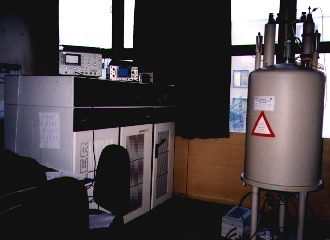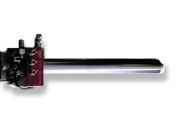Equipment
The laboratory is equipped by a solid-state NMR spectrometer Bruker Avance 500 WB/US with four probe-heads. Three 4-mm CP/MAS probe-heads allow the measurement of NMR spectra of wide range of nuclei starting from nitrogen 15N up to phosphorus 31P with maximum spinning frequency 18 kHz. Optionally 1H or 19F can be decoupled during acquisition or used for cross-polarization or direct detection. The double resonance probe-head PH MAS WVT 500 WB BL4 N-P/H-F is optimized to measure NMR spectra in wide range of temperatures (-120C to 300C).
The triple-resonance 4-mm CP/MAS probe-head PH MAS DVT 500WB BL4 X/Y/H with ordinary temperature range (-100C to +100C) is designed to perform triple-resonance experiments like double cross-polarization, REDOR , TEDOR etc. to correlate nuclei 15N with 13C and/or 27Al with 29Si depending on the insert applied. In addition the power levels required to achieve high efficiency of homonuclear (eg FSLG, PMLG) and heteronuclear (eg TPPM, XiX) decoupling an be easily reached using this probe-head. This enhances stability of the experiment and reduces heating of the sample. The overall stability is necessary prerequisite to perform long-time three-dmensional experiments like 1H-1H-13C correlation. In addition proton background is negligible making possible to detect directly 1H MAS NMR spectra.
The 2.5-mm CP/MAS probe-head PH MAS DVT 500WB BL2.5 N-P/F-H is designed for the measurement of ultra high-speed 1H and 19F MAS NMR spectra or high-quality two-dimensional multiple-quantum NMR spectra of quadrupolar nuclei like 27Al or 23Na. Maximum spinning frequency is ca. 32 kHz. This probe-head is also suitable to perform NMR experiments with small amount of isotopically enriched materials. Due to the smaller outer diameter of 2.5 mm rotor frictional heating of the sample is less intensive. [J.Brus, Solid State Nuclear Magnetic Resonance 16 (3), 151-160 (2000)].
Research potential of our laboratory is significantly extended by 4-mm HR/MAS probe-head PH HRMAS 500WB BL4 HCD ZG that is designed for measurement of high-resolution spectra of soft materials like gels, swollen low density networks (contact lens), viscous liquids, biological materials, foods etc. This probe/head is equipped by z-gradient coils, deuterium lock-channel and it is optimized for the inverse detection. Consequently highly resolved two-dimensional data can be easily obtained because the field stability enhanced by anti-vibration dampers is superior. The volume of the sample is only 12 or 50 microliters.












